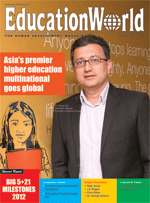Big dreams
 I read your cover story on the Manipal Education & Medical Group’s ambitious plans to go global (EW January) with great interest. This is the first time I’ve heard of an Indian education ‘exporter’ with established campuses in Dubai, Malaysia, Nepal and Antigua.
I read your cover story on the Manipal Education & Medical Group’s ambitious plans to go global (EW January) with great interest. This is the first time I’ve heard of an Indian education ‘exporter’ with established campuses in Dubai, Malaysia, Nepal and Antigua.
Of course, the parent Manipal University in Udupi enjoys an excellent reputation across the country, and is perhaps India’s only world-class university in terms of infrastructure and facilities. But it’s a great idea to apply the knowledge and expertise developed over the years in the university to promote institutions abroad. You rightly state in the story that Manipal has mastered the art of providing high-quality professional education at affordable price. Students in developing countries such as Malaysia and Kenya — where the group is building campuses — are sure to appreciate India’s ‘soft power’.
Congratulations to Dr. Ranjan Pai and Mohandas Pai for dreaming big!
Shivshankar Kumar
Delhi
Forced flight
The January cover story ‘Asia’s premier higher education multinational goes global’ (EW January) was informative. Though the Manipal Group’s global expansion plans need to be applauded and supported, we should be ashamed that such an excellent group of education institutions is being forced to venture abroad, when there is a huge unfulfilled demand for higher education in India.
At the Central and state government levels, the procedures and processes for clearing new projects in higher education are so cumbersome and slow that even the most determined edupreneurs get disheartened and frustrated. The Central government has set a target of increasing gross student enrolment ratio in higher education from the current 13 to 30 percent by 2020. There is no way we can get anywhere near this target without participation of the private sector, given that the Central and state governments are bankrupt.
Anil Desai
Mumbai
Brazen subversion
It’s shocking beyond belief that the annual household income limit set by the Karnataka government for admission of students under the RTE (Right to Education) quota is Rs.3.5 lakh (Education News, EW January). In a country where over 70 percent of the population survives on less than Rs.20 per day, it’s impossible to understand with what logic the education department has defined households with annual income of upto Rs.3.5 lakh as ‘poor’.
The objective of the RTE Act’s 25 percent quota is to provide children from below poverty line households and families access to quality private education. It’s plain as a pikestaff that the s.12 (1) (c) provision is being brazenly subverted by self-serving bureaucrats intent upon grabbing free private education for themselves. Government officials who stipulated this provision must be publicly exposed.
Manish Srivastava
Bangalore
Regulate preschool education!
Your December cover story featuring the EW India Preschool Rankings 2012 (EW December) made interesting reading. Obviously a lot of time, money and effort was expended in compiling the rankings of preschools in six major cities. I am sure the Top 20 league tables of preschools will serve as a useful guide to parents.
However as an educationist, I am concerned about the unregulated mushrooming of preschools across the country, particularly in Bangalore. In almost every locality, I see outdoor advertising inviting parents to enroll their children. Since preschools are unregulated by government with no licence required to start them, I fear the majority of them provide sub-standard facilities with age-inappropriate curriculums delivered by unqualified and poorly trained teachers. Forcing infants to learn the 3 R’s in regimented classrooms prematurely could put them off learning forever.
I strongly advocate regulation and accreditation of facilities, teacher qualifications and curriculums offered by all preschools, preferably by a non-government association. This is necessary to ensure standardisation and development of a sustainable ECE delivery model.
Vijaya Subramaniam
Bangalore
Grave injustice
We would like to bring to your attention the arbitrary and unjust manner in which Dr. G.N. Saibaba, assistant professor at Ramlal Anand College who is physically challenged, has been served an eviction order by the Delhi University administration. The Delhi University Teachers’ Association (DUTA) held an emergency meeting of its executive committee on January 17 to discuss the disturbing and agonising circumstances which have forced Dr. Saibaba to move from his current residence in the Warden’s Quarters at Gwyer Hall Hostel, without any provision for suitable alternative accommodation with wheelchair access.
There is no truth whatever in Delhi University’s claim that Dr. Saibaba is not a university employee. He is an assistant professor of English in a university-affiliated and administered college. Hence, under the provisions of the Persons with Disability Act, 1995, the university is duty-bound to provide Dr. Saibaba suitable accommodation and wheelchair access within close proximity of his workplace, on a permanent basis. DUTA has demanded that until alternative accommodation is made available, the university must allow him the continued use of his current accommodation. The association also strongly condemns the outrageous manner in which the university has resorted to intimidating and harassing Dr. Saibaba by cutting off electricity and telephone lines to his residence.
Hence, DUTA has resolved to immediately seek the intervention of the President and vice president of India, as well as the HRD minister, to prevent the university from committing any further outrage against Dr. Saibaba.
Amar Deo Sharma
President, DUTA
Delhi















Add comment